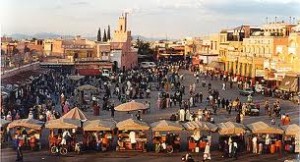
Test the market in Marrakesh
Marrakesh has been transformed from dusty hippie outpost to one of North Africa’s swishest destinations, a vital call on the glitterati’s grand tour. This magical boom city boasts boutique hotels furnished in high style, celebrity chef-run restaurants and deluxe hammams. But inside its sophisticated wrapping, the writer finds the old city little changed, with its masterpiece 11th century minaret rising above a sea of terracotta roofs and an ancient square saved for the world. This is his must-do Marrakesh list.
The square’s a stage
The real-life human tableau played out over centuries in Djemmaa el Fna square – cobra charmers, drummers, acrobats, dancers, story-tellers, spice-cake sellers, celebrated by the smoke ring -blowing hippies of “Marrakesh Express” by Crosby, Stills and Nash — was dying out. The locals campaigned to save something amazing and precious, its roots firmly in the Middle Ages, and their protests were heard at the highest level. The UN‘s’ cultural body UNESCO came up with a completely new designation – “ Masterpieces of the Oral and Intangible Heritage of Humanity.” This square is the very first one. They moved out the bus station in 2000, and the beat, and the bustle, goes on.
Riad deals
Morocco, and especially Marrakesh, sets itself apart with its own version of seductive boutique hotel accommodation. Riads are compact townhouses with a cool, secluded central courtyard, often smothered in greenery. They come with designer panache and many pampering touches, from scattered rose petals and pastries in your room to lounging on embroidered pillows by the pool. There is top of the range cosseting, too, in the city’s big, opulent hotels. In the ritzy Royal Mansour, new in 2010, Art Deco meets traditional Moroccan design. The hotel was commissioned by King Mohammed VI, who is driving the country’s pizzazz. And La Mamounia, haunt of celebrities down the years, recently reopened after a lavish makeover .
Sites to see
A typical day’s sightseeing in Marrakesh takes in Jardin Majorelle, a botanical garden once owned by Yves Saint-Laurent, the 16th-century Ben Youssef Madrasa, for its mosaic tiles and cedar panels, and the sumptuous Bahia Palace, built for a grand vizier’s four wives and 24 concubines. And all this under the shadow of the wondrous 220 ft minaret of the 11th century Koutoubiya Mosque. Late, afternoon, as you begin to flag, head for a hammam, a stress reliever across the Middle East and North Africa. At smart places such as Les Bains de Marrakech, standard luxuries include a lathering with black Moroccan beldi soap flavoured with sesame seeds and a four hand massage. The upmarket hotels have their own hammam.
Seek the Souk
If you worry about the dark side of mass production that underpins so much of the retail world, take a walk through the tangle of alleys of the souks of Marrakesh. They work hard here, but to the honest, flat-out zing of traditional trade. You can see craftsmen at their centuries-old skills — in the Babouche (slipper) Souk, the Dyers’ Souk with its riot of colours , the Ironworkers Souk, and the Carpet Souk. There’s a European variation on the local produce in a string of smart boutiques and emporia dotted around the Medina (Old Town). Look for sleek ceramics, Arabesque embroidered blouses, striped hammam towels and djellebas, old silk carpets and hand made kilims.
Amazing gaze
You can read the soul of a nation through its eyes. In the wonderful new Maison de la Photographie (House of Photography), Moroccan tribesmen, wrapped in their woollen haiks (blankets), fix you with their proud and noble gaze. These portraits of the last representatives of a disappearing way of life are part of a private collection of 3500 photos from Morocco, dating from 1870 to 1950. A star exhibit is the first colour documentary, made in 1957, of the tribal Berbers of the nearby High Atlas Mountains. Some rare earlier photographs were made on glass plates by aristocratic European travellers. After this visual bounty, climb to the roof terrace cafe, for good food and splendid views over the old city. Read more.
Street eats
Every evening they fire up a feast in Djemmaa el Fna Square. Join a queue to be served the latest superior street food from grills and steaming cauldrons – tonight it could be bean soup, sizzling aubergine, and chicken tagine with caramelized pumpkin. Tomorrow you might want to compare the new crop of incoming celebrity chefs’ take on the perfect simplicity of Moroccan cuisine. So much of it is based on that elegant grain made from semolina, couscous. My local favourites include pastilla – pigeon cooked in flaky pastry with pistachios and almonds, topped with cinnamon and powdered sugar. I like the recently renovated Grand Café de la Poste, all potted palms and brown leather sofas, for French fare with a Moroccan accent.
